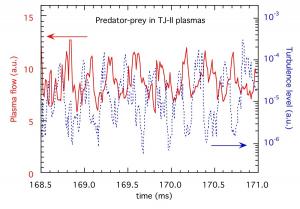A predator-prey relationship in the plasma jungle
11 Feb 2013
-
Phil Dooley, EFDA
Data from the TJ-II stellarator showing oscillations in the turbulence, slightly ahead of oscillations in the flow.
There is a predator on the loose in Madrid. It's been discovered in the fusion laboratories of CIEMAT, preying on its favourite victim ... Turbulence!
This predator is not a large feline, but a type of plasma behaviour known as zonal flows. Strangely enough the relationship between zonal flows and turbulence follows exactly the same pattern as that between the numbers of predators and their prey in the wild—a significant discovery for fusion scientists in the quest to control the turbulence that allows energy to escape from their experiments.
In the same way that a large number of prey—for example, deer—might support an increasing population of tigers, in certain conditions turbulence seems to trigger the growth of the zonal flow pattern.
However as they grow, the zonal flows inhibit the turbulence, which dies away, eventually undermining the zonal flows, in the same way as a large population of tigers would cause a decline in the deer population, leading to their own downfall. But as the tiger population drops, the deer begin to thrive again, and so the cycle begins anew. This oscillatory predator-prey relationship is exactly what has been measured in the TJ-II stellarator at CIEMAT, as shown in the figure.
The scientist who made the discovery is Dr Teresa Estrada, head of microwave and laser diagnostics at TJ-II. "It was a lucky discovery!" she said. "I was not looking for this, the timescale of the oscillations is milliseconds so I could easily have missed it. I saw [the oscillations] first in the turbulence, and so I looked at the flow and was excited to see them there too, with the characteristic ninety degree phase delay."


